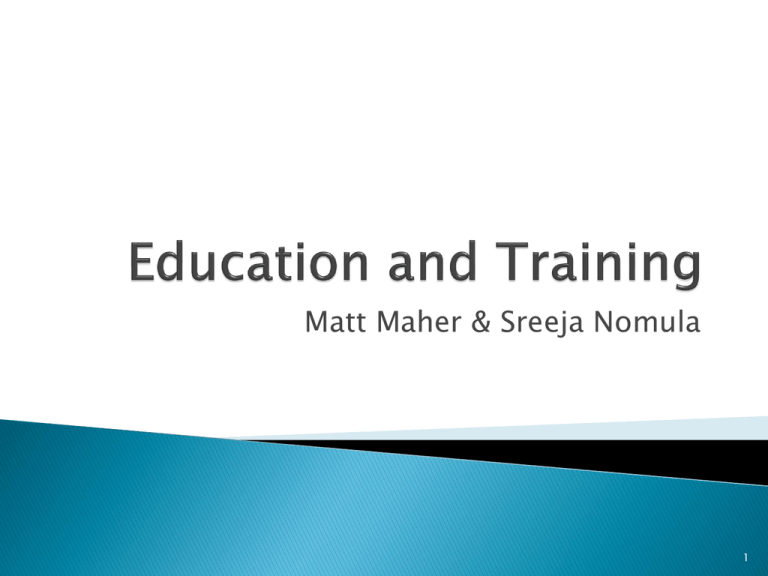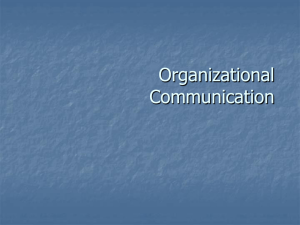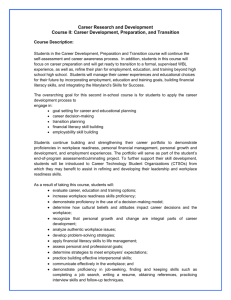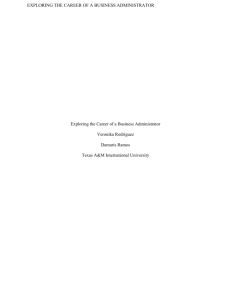Team 2 Education and Training
advertisement

Matt Maher & Sreeja Nomula 1 Define ◦ Education ◦ Training ◦ Learning 2 Explain the differences and similarities between: ◦ Education ◦ Training ◦ Learning 3 “a field of study that deals with the methods and problems of teaching” Typically in a classroom Education provides theoretical knowledge 4 “is an organized, systematic series of activities designed to enhance an individuals work-related knowledge, skills, and understanding or motivation” Typically in a less formal environment Immediate, particular, and practical 5 What qualities does a trainer need to possess? 6 “the activity or process of gaining knowledge or skill by studying, practicing, being taught, or experiencing something : the activity of someone who learns” What does understanding have to do with learning? 7 People learn if they want to learn People learn more easily when they can relate it to something they already know People learn by doing The more people do something the more they will remember and understand how to do it People need immediate feedback to know if they have learned When learning is successful people tend to want to learn more 8 “Forget quality, just sell harder” or “Improve quality and you won’t have to sell so hard” Which one would you choose? 9 Percentage of U.S. Companies that Provide Training to Employees Production Personnel 33% Sales Reps 40% Customer Service Reps 45% Senior Managers 59% Professionals 60% Office Personnel 67% Executive Managers 67% Supervisors 73% Middle Managers 75% 0% 10% 20% 30% 40% 50% 60% 70% 80% 90% 100% 10 In-house Training ◦ ◦ ◦ ◦ ◦ Seminars Workshops Videos Audiotape Computer assisted instruction 11 External Training ◦ ◦ ◦ ◦ ◦ College University Private training Vendor-sponsored training Training provided by skilled and professional associations 12 What types of skills should be improved through training in the workplace? 13 Diversity and Culture Change Technology Quality employees 14 At first workers from different backgrounds don’t feel comfortable Having a diverse workplace does not mean people will work together well So we need to train this diverse group to work in as a team What type of training needs to be provided in this situation? 15 Methods and procedures that are used today may be completely different tomorrow Constantly update training to stay ahead in the marketplace 16 New technology is brought into the workplace to utilized Without training these new technologies can not be used correctly and efficiently or at all 17 If you want high-quality employees you need a labor force that has been highly educated Employees need to be able to adapt and quickly learn in a new environment Training must be started with the basics so that employees can begin to understand advanced material 18 How can the need for training be recognized in certain areas of a company? 19 Observation ◦ For example, specific problems, difficulties in task performance, bottlenecks, etc. Brainstorming Sessions ◦ Ask employees what training needs they have ◦ For example, what tasks they perform well and what tasks they do not perform well and what tasks they can’t perform at all 20 Job Task Analysis Survey ◦ Develop a survey which will discover what skills employees have and what skills they lack Employee groups focused on quality specifically to training ◦ Without managers and supervisors ◦ More likely to admit their training needs Set performance standards 21 Examples ◦ ◦ ◦ ◦ ◦ New skills Utilizing new technologies More positive attitudes in the workplace Safety in the Workplace Having equality and harmony in the workplace 22 State the specific objective of the training ◦ Employees will learn how to safely operate a utility knife This will make it easier to provide and evaluate training 23 What are the benefits of training? 24 What methods are there to provide training? 25 Internal Approaches External Approaches Partnership Approaches E-Learning 26 On-site training in the company’s facility ◦ ◦ ◦ ◦ One-on-one training On-the-job computer based training Formal group instruction Media based instruction What are the Advantages and Disadvantages of the internal approach? 27 Usually given to employees that are less experienced or new Also useful for preparing to replace a highlevel employee 28 Allows employee to learn at their own speed Can be more specific to the employee Gives immediate feedback to employee Used to improve general knowledge Can be used at anytime without a need for a trainer 29 Used for a group of employees who share a common training need ◦ ◦ ◦ ◦ ◦ ◦ ◦ ◦ Lectures Case studies Demonstrations Hands-on Q and A Role-playing Drills Storytelling 30 Media-based may include packages involving ◦ ◦ ◦ ◦ ◦ Video Audio Workbooks Computer Slide shows 31 Off-site training away from the workplace Used for developing general skills Involves ◦ Short-term training where employees enrolled for a few hours to a few weeks ◦ Long-term training where employees are enrolled in college courses What are some advantages and disadvantages? 32 Having a partnership with education institutions The institution has customized courses for an organization Another advantage of this method is the credibility and standardization 33 Video Conferencing Audio conferencing Web meetings Online universities 34 Should training be voluntary or required, and why? 35 Was the training valuable to the employees job? Did they retain the information that was taught? Can you see what was learned being utilized in the workplace? Has the training made a difference? 36 Student evaluates the training session ◦ Organization of course e.g. were the objectives clear ◦ Teaching methods and skills e.g. were the lectures effective ◦ Value of the Course e.g. was the value of the course outstanding or poor 37 What causes training to fail? 38 Poor teaching Inadequate resources Poor planning Lack of funds Lack of commitment Lack of participation Being too specific at first 39 Quality Planning Training ◦ Provides a roadmap to meet the quality standards Quality Control Training ◦ Uses control tools to maintain quality Quality Improvement Training ◦ Utilizes quality improvement tools and techniques 40 The training of ethical behavior Companies can have different ethical standards Common business ethics on the job are: ◦ ◦ ◦ ◦ ◦ ◦ Integrity Loyalty Responsibility Empathy Confidentiality Respect 41 Inform customer what they need to know and expect from a product Proper usage of the product ◦ e.g. user manuals, on-site technical assistance, customer service trainers 42 Education. (n.d.). Merriam-Webster.com. Retrieved from http://www.merriamwebster.com/dictionary/education Goetsch, D. L. & Davis, S. (2009). Quality Management for Organizational Excellence: Introduction to Total Quality. Upper Saddle River, NJ: Prentice Hall How to identify training needs. (n.d.). Startupdonut.co.uk. Retrieved from http://www.startupdonut.co.uk/startup/employees/people-management/how-to-identifytraining-needs Learning. (n.d.). Merriam-Webster.com. Retrieved from http://www.merriamwebster.com/dictionary/learning The Advantages & Disadvantages of In-House Training. (n.d.). OptimusSourcing.com. Retrieved from The Most Effective Training Techniques. (2013). Trainingtoday.blr.com. Retrieved from http://www.optimussourcing.com/training-news/the-advantages-disadvantages-of-in-housetraining http://trainingtoday.blr.com/employee-training-resources/How-to-Choose-the-MostEffective-Training-Techniques 43











